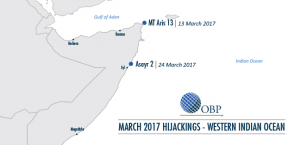 According to the Oceans Beyond Piracy (OBP), Somali pirates have kept 7 hostages on board the vessel hijacked on March 23th 2017 off Somalia, indicating that it could be intended for use as a mother ship for further attacks.
According to the Oceans Beyond Piracy (OBP), Somali pirates have kept 7 hostages on board the vessel hijacked on March 23th 2017 off Somalia, indicating that it could be intended for use as a mother ship for further attacks.
Details of the attack:
The vessel, named Asayr 2, is a Somali cargo dhow operating out of Bosasso
Attacked by 6 pirates in 2 skiffs
The vessel carried an estimated crew of 20 and one Somali guard
After the hijacking, the pirates reportedly dropped off most of the crew and the embarked guard near the village of Maraya in Somalia’s Puntland state and returned to sea with the Asayr 2.
The pirates have reportedly kept 7 hostages on board the vessel which may indicate that the vessel could be intended for use as a mother ship for further attacks.
The escalation in pirate activity is troubling, but does not necessarily indicate a large scale trend in the renewal of pirate activity, since attacks against dhows have been historically under-reported by major agencies over the last few years.
The attack and suspected intention to use the Asayr 2 as a mother ship is alarming since the use of this vessel could enable the pirates to threaten a larger geographic area.
The two recent attacks near the Puntland coast indicate a pressing need for the shipping industry to remain vigilant and employ industry recommended Best Management Practices when transiting the area.
Under-reporting of attacks on Dhows and Fishing Vessels
Attacks on dhows and small fishing vessels like the Asayr 2 are not uncommon and have occurred along the Somali coast over the last few years, despite larger reporting agencies not reporting such incidents. For example OBP’s last report (for 2015) recorded five dhow hijackings, a failed attack on the fishing vessel Mook Andaman 28, nine incidents suspected of being piracy-related, one armed robbery, and a number of reported suspicious incidents.
The potential for the Asayr 2 to be used as a mothership is alarming as it could extend the range of the pirates and expose the crew to increased dangers. At the height of the piracy crisis off Somalia in 2010 and 2011, OBP’s Human Cost of Piracy reports noted that pirates frequently used pirated dhows and fishing vessels as motherships to search for other targets on the ocean. For those two years alone, over 1000 crewmen were forced to facilitate pirate attacks, either as human shields or to man motherships used in attacks on larger vessels. OBP also found that the crews of these vessels frequently were subjected to greater rates of extreme abuse at the hands of their captors as compared to other hostages.

This attack shows that Somali pirates still possess the capability and intent to capture vessels. Additionally tensions in coastal communities about illegal fishing in Somali waters continue to escalate. At the same time vessels are transiting closer to shore, with low freeboard and at slow speeds are granting pirates access to vulnerable vessels. The attack on the Asayr 2 and the ARIS 13 should be taken as a warning to the seafaring community that there is the potential for piracy in the region and that appropriate safety measures such as the industry recommended Best Management Practices should continue to be followed.
Source: Safety4sea
